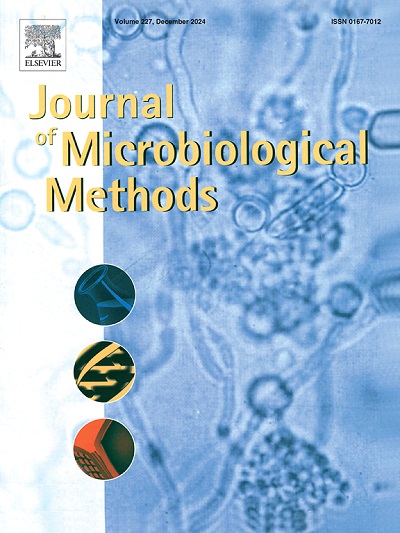Strain-level typing of Wickerhamomyces anomalus using Fourier transform infrared spectroscopy and whole-genome sequencing
IF 1.9
4区 生物学
Q4 BIOCHEMICAL RESEARCH METHODS
引用次数: 0
Abstract
In industrial settings, identifying the source of microbial contamination is crucial for effective microbiological risk assessment. While various strain identification technologies exist, many struggle with practicality, accuracy, and reproducibility. Fourier Transform Infrared Spectroscopy (FT-IR) has emerged as a rapid method, demonstrating a strong correlation with whole-genome sequencing (WGS) for certain bacteria. However, its accuracy for identifying yeast strains has been limited.
This study focuses on improving the accuracy of FT-IR for yeast strain identification by optimizing pretreatment conditions. We conducted phylogenetic analyses on Wickerhamomyces anomalus using both WGS single-nucleotide polymorphisms (SNPs) and FT-IR. Although initial FT-IR results were less accurate than WGS, refining the culture and sample preparation conditions led to significant improvements. We tested 16 different conditions, using Euclidean Distances (EDs) and dendrogram comparisons to evaluate discrimination ability, including metrics like the F-measure and adjusted Rand index (ARI).
The most accurate and reproducible FT-IR results were achieved with incubation in Sabouraud dextrose (SD) broth aligning closely with WGS results. This optimized FT-IR protocol now allows for rapid and precise strain-level discrimination of W. anomalus, offering a practical tool for tracking contamination sources in industrial environments.
利用傅里叶变换红外光谱和全基因组测序对异常柳杉进行品系分型。
在工业环境中,确定微生物污染源对于有效的微生物风险评估至关重要。虽然存在各种菌株识别技术,但许多技术在实用性,准确性和可重复性方面存在问题。傅里叶变换红外光谱(FT-IR)已经成为一种快速的方法,证明了与某些细菌的全基因组测序(WGS)有很强的相关性。然而,该方法对酵母菌株鉴别的准确性有限。本研究旨在通过优化预处理条件,提高FT-IR酵母菌株鉴定的准确性。利用WGS单核苷酸多态性(SNPs)和FT-IR对异常Wickerhamomyces anomalus进行了系统发育分析。虽然最初的FT-IR结果不如WGS准确,但改进培养和样品制备条件导致了显着改善。我们测试了16种不同的条件,使用欧几里得距离(EDs)和树形图比较来评估辨别能力,包括f测量和调整后的兰德指数(ARI)等指标。在Sabouraud葡萄糖(SD)培养液中孵育获得了最准确和可重复性的FT-IR结果,与WGS结果非常接近。这种优化的FT-IR协议现在允许W. anomalus的快速和精确的菌株水平判别,为跟踪工业环境中的污染源提供了实用的工具。
本文章由计算机程序翻译,如有差异,请以英文原文为准。
求助全文
约1分钟内获得全文
求助全文
来源期刊

Journal of microbiological methods
生物-生化研究方法
CiteScore
4.30
自引率
4.50%
发文量
151
审稿时长
29 days
期刊介绍:
The Journal of Microbiological Methods publishes scholarly and original articles, notes and review articles. These articles must include novel and/or state-of-the-art methods, or significant improvements to existing methods. Novel and innovative applications of current methods that are validated and useful will also be published. JMM strives for scholarship, innovation and excellence. This demands scientific rigour, the best available methods and technologies, correctly replicated experiments/tests, the inclusion of proper controls, calibrations, and the correct statistical analysis. The presentation of the data must support the interpretation of the method/approach.
All aspects of microbiology are covered, except virology. These include agricultural microbiology, applied and environmental microbiology, bioassays, bioinformatics, biotechnology, biochemical microbiology, clinical microbiology, diagnostics, food monitoring and quality control microbiology, microbial genetics and genomics, geomicrobiology, microbiome methods regardless of habitat, high through-put sequencing methods and analysis, microbial pathogenesis and host responses, metabolomics, metagenomics, metaproteomics, microbial ecology and diversity, microbial physiology, microbial ultra-structure, microscopic and imaging methods, molecular microbiology, mycology, novel mathematical microbiology and modelling, parasitology, plant-microbe interactions, protein markers/profiles, proteomics, pyrosequencing, public health microbiology, radioisotopes applied to microbiology, robotics applied to microbiological methods,rumen microbiology, microbiological methods for space missions and extreme environments, sampling methods and samplers, soil and sediment microbiology, transcriptomics, veterinary microbiology, sero-diagnostics and typing/identification.
 求助内容:
求助内容: 应助结果提醒方式:
应助结果提醒方式:


